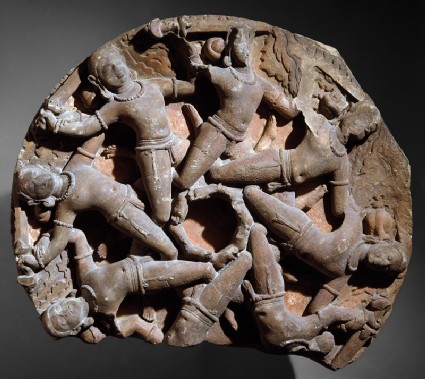Room 32 | India 600-1900 gallery
Explore Hindu, Buddhist and Jain art from India, the Himalayas and Southeast Asia.

Galleries : 299 objects
- Reference URL
Actions
Boss from a temple ceiling with circle of flying warriors
-
Details
- Associated place
-
Asia › India › west India › Rajasthan › south Rajasthan (place of creation)
- Date
- 2nd half of the 8th century - 1st half of the 9th century AD
- Material and technique
- sandstone, with traces of pigment
- Dimensions
-
63 x 76 x 9 cm max. (height x width x depth)
76 cm irregular, max. (diameter)
- Material index
- Technique index
- Object type index
-
sculpture › relief › temple-relief,
- No. of items
- 1
- Credit line
- Purchased with the assistance of the MLA/V&A Purchase Grant Fund, 1985.
- Accession no.
- EA1985.5
-
Further reading
Harle, J. C., and Andrew Topsfield, Indian Art in the Ashmolean Museum (Oxford: Ashmolean Museum, 1987), no. 32 on pp. 24-25, pp. xiv, 12, & 40, pl. 5 (colour) & p. 24
Penny, Nicholas, The Materials of Sculpture (New Haven: Yale University Press, 1993), illus. p. 107 fig. 97
New York: Asia Society Galleries, 31 March-15 August 1993, and Kansas City, Missouri: Nelson-Atkins Museum of Art, 10 October-28 November, 1993, Gods, Guardians and Lovers: Temple Sculptures from North India, A.D. 700-1200, Vishakha N. Desai and Darielle Mason, eds (New York: Asia Society Galleries in association with Mapin Publishing, Ahmedabad, 1993), no. 38 on p. 204
Piper, David, and Christopher White, Treasures of the Ashmolean Museum: An Illustrated Souvenir of the Collections, revised edn (Oxford: Ashmolean Museum, 1995), no. 119 on p. 114, illus. p. 114 fig. 119
Oxford: Ashmolean Museum, 24 May 2006-23 December 2008, Treasures: Antiquities, Eastern Art, Coins, and Casts: Exhibition Guide, Rune Frederiksen, ed. (Oxford: Ashmolean Museum, 2006), no. 175 on p. 62, illus. p. 62
Location
Objects are sometimes moved to a different location. Our object location data is usually updated on a monthly basis. Contact the Jameel Study Centre if you are planning to visit the museum to see a particular object on display, or would like to arrange an appointment to see an object in our reserve collections.
Galleries
Publications online
-

Indian Art in the Ashmolean Museum
This splendid circular composition of eight male figures, their legs interlocked and radiating out like the spokes of a wheel, is in the finest early post-Gupta (c.AD. 550-950) style, with a rhythm and a liveliness which is characteristic at this time of the carving of ceiling slabs and figures on door lintels rather than of full length images of the gods. Note the quality of the carving and precision, to within millimetres, of the placing of the interlocking legs and feet
Carved ceiling slabs are a feature of temples in the Deccan and northern India after the Gupta period. At this time they bear relatively simple compositions of gods and demi-gods; in later times they become almost incredibly intricate, with scores of figures in increasingly abstract patterns, but the sculptural qualities much diminished. The circular shape and relatively small size of this slab suggest it once belonged to the porch of a small temple; alternately it may have adorned one portion of a coffered ceiling in the hall of a larger shrine.
Each figure holds a sword, and there are indications, of clouds (or flames?) in very low relief on the ground. These are not sufficient clues to enable the right figures to be indentified. Being eight in number suggests the aṣṭadikpālas or guardians of the eight directional quarters, but by this time these have individual identities. The aṣṭamūrtis related to the different elements (fire, air, water, etc.) seem more likely candidates in view of the relief carving on the ground.
One authority, however, has suggested that these figures, in what is essentially the "flying" poser, might be vidyādharas, magicians and semi-divine creatures of the air. They do not, as a rule carry anything but wreaths or garlands. The name means literally “bearers of magical powers”. Viṣṇu’s sword is named Vidyā on occasion and the ceiling slab could, in a Viṣṇu temple, be a meaningful and appropriate semi-verbal, semi-visual pun. Another possibility is that eight Vasus, creatures of the elements, are represented here.
An engraving of a roughly similar slab was published by Burgess and Cousens as being one of two in a small ruined temple at Vadnagar. It shows sixteen men holding swords similarly grouped, although the legs, partly due to the increased number, are more awkwardly arranged. The number sixteen does not immediately suggest a group of deities. From its style the slab appears to be of a later date.
Notice
Objects may have since been removed or replaced from a gallery. Click into an individual object record to confirm whether or not an object is currently on display. Our object location data is usually updated on a monthly basis, so contact the Jameel Study Centre if you are planning to visit the museum to see a particular Eastern Art object.
© 2013 University of Oxford - Ashmolean Museum




